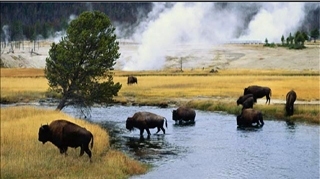|
First Transcontinental Drive by Automobile
Mysteries of the Museum TV
program –
A March 2014 program featured an
artifact in a San Francisco museum –
A
1903 Winton automobile driven by Dr. H. Nelson Jackson across the continent
from San Francisco to New York City during the summer of 1903.
He had a young mechanic along and picked up a dog along the way (purchased,
not a stray). They fitted him with goggles because of the dust.
Toward the end of the trip they heard that Packard had outfitted a crew to
do the same thing.
Dr. Jackson was
determined to be first so he drove as fast as he could, sometimes reaching
speeds of 30-35 mph.
When he reached New York
he learned the Packard people were 1200 miles behind.
The map of their route shown on the program was not detailed but did show a
curve downward in the center of the continent, like they were following the
Platte through Nebraska.
Question: Did they pass through Kearney?
Kearney Hub – July 11, 1903 –
San Francisco to New York
Two Automobile Tourists Lay Up in Kearney for Repairs
Dr. H. Nelson
of Burlington, Vt. & Sewall Crocker of Tacoma, WA were making this trip
Stopped for
repairs – auto was given an overhauling by T. H. Bolte [the man who built
the first automobile in Kearney.]
Left San
Francisco May 28, went up to Ontario, Oregon [on Idaho border, pop 445],
followed the railroad right of way most of the way to Kearney
Side trips
for hunting and fishing
Had traveled
about 3,600 miles so far – planned to reach NY in 3 weeks, then to
Burlington
Car was
20-horse power, 2000 lb. vehicle manufactured by Winton Motor Carriage
company in Cleveland, OH
A Story Left from March (March
1914)
Sheriff’s dilemma -
A
lady from New Jersey wrote a letter to the county sheriff saying she is
willing to leave the east and move west.
(She was looking for a husband)
She didn’t expect a millionaire or
handsome man but wants one who is upright, honest and capable of providing a
suitable home.
She was a trained nurse, 5’7”,
weighed 135 lbs. and was a widow.
Her daughter, 21, also weighed 135
but was 5’ tall and was also looking for a husband.
The sheriff was not planning to
advertise for husbands for the ladies but would give their address to any
serious applicant.
FYI – 225 years ago on March 4, 1789 – At the first meeting of the
United States congress under the constitution there was not a quorum, and no
business could be transacted. The government was without an executive head.
The Gibbon Courthouse
(from Samuel Bassett's History
of Buffalo County, p. 121-128)
Gibbon Courthouse Construction
April 1872 – Bond issue successfully
past to construct a courthouse in Gibbon, $20,000
Architect from Omaha (Charles
Driscoll) hired to design the building – charged $423
Brick to be made locally in Gibbon
Clay and sand available nearby
Wood from the Loup river @ $6/cord
6 men contracted, 1 w/team of horses;
5 w/yokes of oxen
Oxen = 3
yokes, 2 cords wood, 20 miles without water, drive at night when cooler
3-day trip,
or longer depending on breakdowns or loose wheels.
Green corn for every meal
Completion
Feb. 22, 1873 – First meeting in new courthouse
Public meeting in evening to formally accept the courthouse: speeches, ended
with a dance
When was the bond paid off?
In 1916 when Bassett’s book was
publishes he wrote:
"The county
received in cash for these bonds $17,500
The county
has paid, approximately, in interest $51,480
The county
has yet to pay on bonds
$20,000"
After a discussion of the District Court boundaries (Bassett – p127)
“ Before the first courthouse was
completed agitation had begun for removal of the county seat. Time is too
short, eternity too near, printer's ink and white paper too expensive, to
even attempt to relate the history of a county seat fight.”
(to be continued with building of Kearney courthouses and fate of the Gibbon
building)
|

